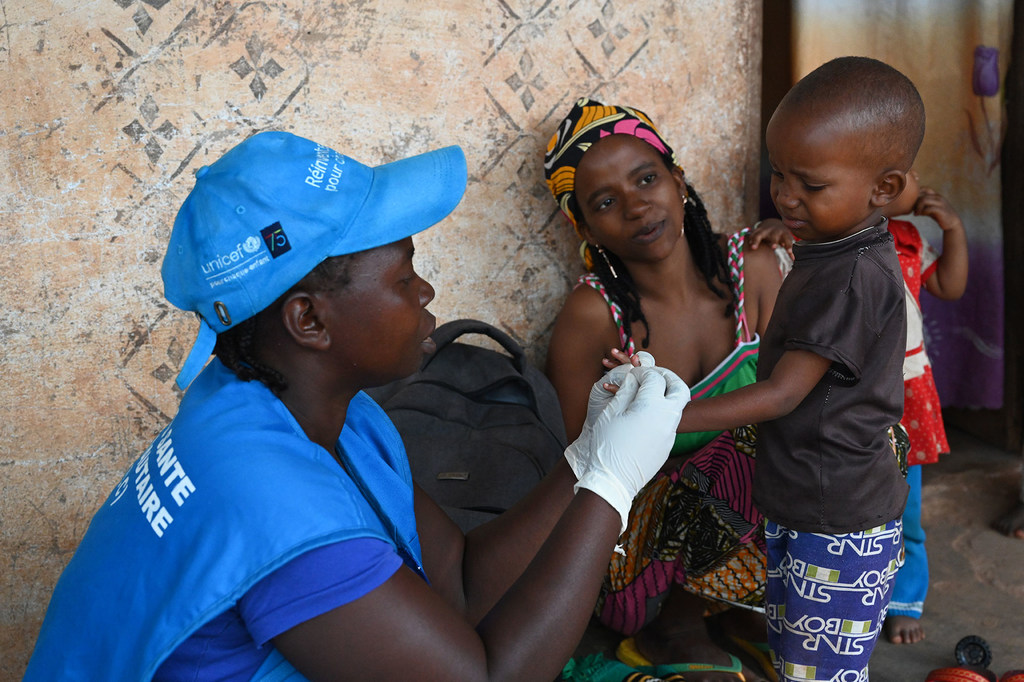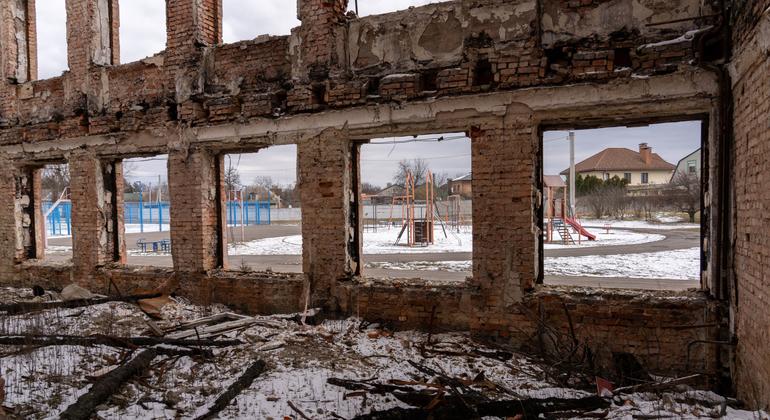News reports said that residential buildings in the northern city of Kharkiv had been hit, killing one and injuring 16, quoting the city’s mayor.
Four children were wounded, with images posted to social media showing extensive damage and a body visible lying on the floor.
The UN’s Denise Brown said that international law must be respected by combatants, adding that there had been a week of daily attacks on cities “which have taken the lives of people and severely impacted vital services.”
Food assistance to Cameroon refugees at risk amid funding shortages
Vital food assistance to refugees in Cameroon may cease unless funding shortfalls can be filled, UN humanitarians have warned.
The alert from the UN refugee agency (UNHCR) and the UN World Food Programme (WFP) affects vulnerable people sheltering in the country’s Far North, Adamawa, East and North regions.

A young boy tests positive for Malaria in eastern Cameroon. (file)
Rations have already been cut in half in these areas, meaning that food baskets have been missing basic staples including pulses, vegetable oil and salt.
“Without immediate support we will have no option but to further cut the already meagre portions on refugees’ plates, with all the devastating impacts this will bring including rising malnutrition and hunger,” said Wanja Kaaria, WFP Country Director in Cameroon.
Less study, less food
Ms. Kaaria explained that families facing hunger cope by pulling children out of school and eating less food; this affects women and children especially, she warned.
Cameroon continues to be affected by three humanitarian crises; one is in the Far North and linked to violence and insecurity close by, in Lake Chad and Nigeria.
The second is in the Northwest and Southwest regions, where armed groups are fighting Government forces, and the third is in neighbouring Central African Republic (CAR).
Thousands of people have been uprooted by fighting, fleeing to Cameroon for shelter, meaning that the country now hosts more than half a million refugees and asylum-seekers.
The $371 million humanitarian response plan for Cameroon is only five per cent funded.
Older women and those with disabilities at ‘particular risk’ of abuse
Older women and women with disabilities face particular risk of abuse, yet their situation is largely hidden in most countries’ statistics on victims of violence, according to two new publications released on Wednesday by the World Health Organization (WHO).
The UN agency is calling for governments to carry out more thorough research that will help ensure these women are counted, and that their specific needs are understood and addressed.
The data and evidence of gender-based violence amongst these groups, shows a high prevalence.
One systematic review found greater risks of intimate partner violence for women with disabilities compared with those without, while another also found higher rates of sexual violence.
“Older women and women with disabilities are under-represented in much of the available research on violence against women, which undermines the ability of programmes to meet their particular needs,” said WHO’s Dr. Lynnmarie Sardinha, who is the author of the briefs and an expert on data relating to violence against women.
Understanding differences
“Understanding how diverse women and girls are differently affected, and if and how they are accessing services, is critical to ending violence in all its forms.”
Intimate partner and sexual violence are the most common forms of gender-based violence globally and affect around one in three women.
Older women and women with disabilities are still subjected to these types of violence but also face specific risks and additional forms of abuse, sometimes at the hands of caregivers or healthcare professionals.
These include coercive and controlling behaviours such as withholding of medicines, assistive devices or other aspects of care, and financial abuse.
Concern grows over spread of cholera, diarrhoea in Somalia
The UN humanitarian affairs coordination office, OCHA, on Wednesday sounded the alarm over the spread of cholera and acute watery diarrhoea in Somalia, which is grappling with multiple crises.
As of a week ago, nearly 4,400 cases and 54 deaths had been recorded in nearly half of all districts in Somalia, since the beginning of the year, said UN Spokesperson Stéphane Dujarric, briefing correspondents in New York.
Over 60 per cent of the deaths are reportedly among children under five.
WHO said cases this year are three times higher than the previous three-year average and Somalia is already among the countries most severely impacted by cholera and acute watery diarrhoea.
Stepping up response
“We, along with our humanitarian partners, are working with Somalia’s health authorities to step up preparation and response efforts, in line with a six-month plan of action that will require nearly $6 million”, said Mr. Dujarric.
There are severe shortages in the number of available oral cholera vaccine doses, he said, while aid organizations are pre-positioning treatment kits and working on surveillance and case management.
“However, we urgently need additional funding”, he continued. “This year’s humanitarian appeal for Somalia is only 10 per cent funded. We have about $150 million received out of the nearly $1.6 billion that are needed.



